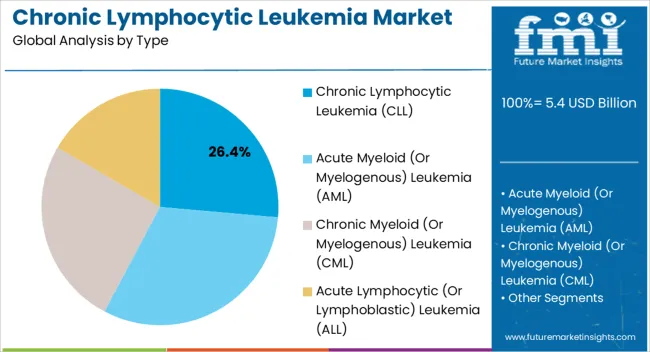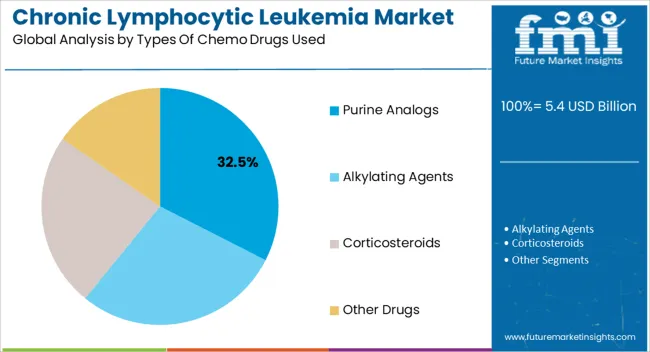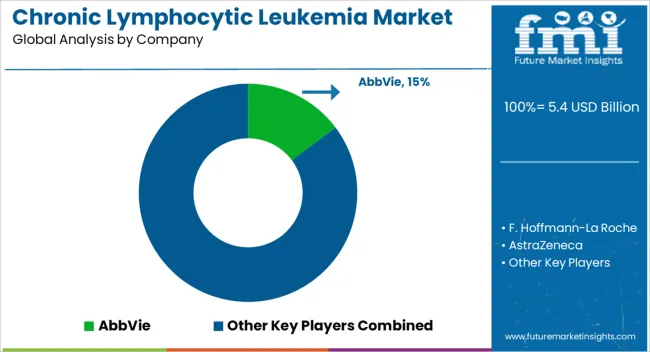The Chronic Lymphocytic Leukemia Market is estimated to be valued at USD 5.4 billion in 2025 and is projected to reach USD 10.3 billion by 2035, registering a compound annual growth rate (CAGR) of 6.6% over the forecast period.

| Metric | Value |
|---|---|
| Chronic Lymphocytic Leukemia Market Estimated Value in (2025 E) | USD 5.4 billion |
| Chronic Lymphocytic Leukemia Market Forecast Value in (2035 F) | USD 10.3 billion |
| Forecast CAGR (2025 to 2035) | 6.6% |
The Chronic Lymphocytic Leukemia (CLL) market is witnessing steady growth, driven by the rising prevalence of CLL globally and increasing awareness of targeted therapies. Advancements in diagnostic tools and early detection techniques are facilitating timely intervention and better treatment outcomes. The market is being further supported by the development of innovative therapeutic options, including oral targeted therapies, immunotherapies, and combination regimens, which improve patient survival and quality of life.
Increasing investments in oncology research, coupled with growing government initiatives to improve cancer care infrastructure, are accelerating the adoption of advanced treatments. Patient-centric approaches, including personalized medicine and precision dosing, are also shaping treatment strategies.
The rising demand for oral formulations and therapies that reduce hospital visits is driving market expansion, particularly in developed regions As healthcare providers continue to focus on effective disease management and reducing treatment-related complications, the Chronic Lymphocytic Leukemia market is expected to sustain growth, supported by ongoing clinical research, new drug approvals, and improved accessibility to therapeutic solutions across global markets.
The chronic lymphocytic leukemia market is segmented by type, drug route administration (roa), types of chemo drugs used, end user, and geographic regions. By type, chronic lymphocytic leukemia market is divided into Chronic Lymphocytic Leukemia (CLL), Acute Myeloid (Or Myelogenous) Leukemia (AML), Chronic Myeloid (Or Myelogenous) Leukemia (CML), and Acute Lymphocytic (Or Lymphoblastic) Leukemia (ALL). In terms of drug route administration (roa), chronic lymphocytic leukemia market is classified into Oral and Parenteral. Based on types of chemo drugs used, chronic lymphocytic leukemia market is segmented into Purine Analogs, Alkylating Agents, Corticosteroids, and Other Drugs. By end user, chronic lymphocytic leukemia market is segmented into Hospitals, Private Clinics, Diagnostic Laboratories, Research Laboratories, Research Institutes, and Drug Store. Regionally, the chronic lymphocytic leukemia industry is classified into North America, Latin America, Western Europe, Eastern Europe, Balkan & Baltic Countries, Russia & Belarus, Central Asia, East Asia, South Asia & Pacific, and the Middle East & Africa.

The chronic lymphocytic leukemia type segment is projected to hold 26.4% of the market revenue in 2025, establishing it as the leading type. Growth is being driven by the high prevalence of this specific leukemia subtype, which primarily affects older adults and often requires long-term disease management. Advancements in treatment protocols, including targeted therapies and combination regimens, have enhanced patient survival rates and quality of life.
Early diagnosis and increased awareness among healthcare providers and patients have further reinforced demand for effective treatment strategies. Research efforts aimed at understanding disease progression, genetic markers, and therapy resistance are supporting the development of more personalized and effective interventions.
The availability of well-established treatment guidelines and access to specialized oncology care are also key contributors to the segment’s growth As the need for tailored therapies and long-term disease management continues to rise, the chronic lymphocytic leukemia type segment is expected to maintain its leading position within the broader leukemia market.
.webp)
The oral drug route administration segment is anticipated to account for 56.8% of the market revenue in 2025, making it the leading administration route. Growth is being driven by the convenience and patient compliance associated with oral therapies, which reduce the need for frequent hospital visits and intravenous administration. Oral formulations enable flexible dosing schedules and improve overall patient quality of life.
Advancements in drug design, including targeted small molecule inhibitors, have further strengthened adoption in chronic lymphocytic leukemia management. Clinical evidence supporting efficacy and safety of oral therapies has increased confidence among healthcare providers, leading to wider prescription. Integration of oral medications into combination regimens allows for personalized treatment approaches and improved therapeutic outcomes.
Patient preference for less invasive administration methods, combined with the benefits of home-based therapy monitoring, continues to propel the segment’s growth As treatment paradigms shift toward patient-centered and outpatient-friendly therapies, oral drug administration is expected to maintain its dominance within the market.

The purine analogs segment is projected to hold 32.5% of the market revenue in 2025, establishing it as the leading chemotherapy drug category. Its growth is being driven by proven clinical efficacy in targeting malignant lymphocytes and inducing sustained remission in chronic lymphocytic leukemia patients. Purine analogs interfere with DNA synthesis in cancer cells, providing a key mechanism for disease control.
The segment benefits from well-documented treatment protocols, clinical evidence, and long-standing adoption in oncology practice. Combination therapy regimens, incorporating purine analogs with other targeted agents or immunotherapies, have further strengthened patient outcomes and expanded applicability. Continuous research into optimizing dosing, minimizing side effects, and enhancing patient tolerability supports sustained use of purine analogs.
Increasing awareness of their therapeutic benefits among hematologists and oncology specialists reinforces prescription patterns As the demand for effective chemotherapy agents continues alongside targeted therapies, the purine analogs segment is expected to maintain its leading position, driven by reliability, efficacy, and integration into modern treatment regimens.
Chronic lymphocytic leukemia (CLL) is a blood and bone marrow disease that usually gets adverse slowly. It is one of the most common types of leukemia in adults. Chronic lymphocytic leukemia is a type of cancer in which the bone marrow makes too many lymphocytes.It may affect red blood cells, white blood cells, and platelets.
Chronic lymphocytic leukemia is the second most common cancer in adult males. About 90% of chronic lymphocytic leukemia is diagnosed in middle age. Incidence rate of CLL is high in men and women over 50 years of age or middle age. It is rarely seen in people under age 40, and is extremely rare in children.
In CLL, majority of the blood stem cells become abnormal lymphocytes healthy white blood cells. The abnormal lymphocytes may also be called leukemia cells. These abnormal lymphocytes are not able to fight infection very well. Also, as the number of lymphocytes increases in the blood and bone marrow, there is less room for healthy white blood cells, red blood cells, and platelets.
This may cause infection, anemia, and easy bleeding which may result in death. In 2025, American Cancer Society has estimated that in the United States about18,960 new cases of chronic lymphocytic leukemia (CLL)and approximately 4,660 deaths by CLL are observed up till now.

| Country | CAGR |
|---|---|
| China | 8.9% |
| India | 8.2% |
| Germany | 7.6% |
| France | 6.9% |
| UK | 6.3% |
| USA | 5.6% |
| Brazil | 4.9% |
The Chronic Lymphocytic Leukemia Market is expected to register a CAGR of 6.6% during the forecast period, exhibiting varied country level momentum. China leads with the highest CAGR of 8.9%, followed by India at 8.2%. Developed markets such as Germany, France, and the UK continue to expand steadily, while the USA is likely to grow at consistent rates. Brazil posts the lowest CAGR at 4.9%, yet still underscores a broadly positive trajectory for the global Chronic Lymphocytic Leukemia Market. In 2024, Germany held a dominant revenue in the Western Europe market and is expected to grow with a CAGR of 7.6%. The USA Chronic Lymphocytic Leukemia Market is estimated to be valued at USD 1.9 billion in 2025 and is anticipated to reach a valuation of USD 3.2 billion by 2035. Sales are projected to rise at a CAGR of 5.6% over the forecast period between 2025 and 2035. While Japan and South Korea markets are estimated to be valued at USD 289.4 million and USD 138.8 million respectively in 2025.

| Item | Value |
|---|---|
| Quantitative Units | USD 5.4 Billion |
| Type | Chronic Lymphocytic Leukemia (CLL), Acute Myeloid (Or Myelogenous) Leukemia (AML), Chronic Myeloid (Or Myelogenous) Leukemia (CML), and Acute Lymphocytic (Or Lymphoblastic) Leukemia (ALL) |
| Drug Route Administration (ROA) | Oral and Parenteral |
| Types Of Chemo Drugs Used | Purine Analogs, Alkylating Agents, Corticosteroids, and Other Drugs |
| End User | Hospitals, Private Clinics, Diagnostic Laboratories, Research Laboratories, Research Institutes, and Drug Store |
| Regions Covered | North America, Europe, Asia-Pacific, Latin America, Middle East & Africa |
| Country Covered | United States, Canada, Germany, France, United Kingdom, China, Japan, India, Brazil, South Africa |
| Key Companies Profiled | AbbVie, F. Hoffmann-La Roche, AstraZeneca, Gilead Sciences, Novartis, BeiGene, Eli Lilly, Sanofi, Incyte, Genmab / AbbVie, Astellas Pharma, Teva Pharmaceutical, Ono Pharmaceutical, and Secura Bio |
The global chronic lymphocytic leukemia market is estimated to be valued at USD 5.4 billion in 2025.
The market size for the chronic lymphocytic leukemia market is projected to reach USD 10.3 billion by 2035.
The chronic lymphocytic leukemia market is expected to grow at a 6.6% CAGR between 2025 and 2035.
The key product types in chronic lymphocytic leukemia market are chronic lymphocytic leukemia (cll), acute myeloid (or myelogenous) leukemia (aml), chronic myeloid (or myelogenous) leukemia (cml) and acute lymphocytic (or lymphoblastic) leukemia (all).
In terms of drug route administration (roa), oral segment to command 56.8% share in the chronic lymphocytic leukemia market in 2025.






Our Research Products

The "Full Research Suite" delivers actionable market intel, deep dives on markets or technologies, so clients act faster, cut risk, and unlock growth.

The Leaderboard benchmarks and ranks top vendors, classifying them as Established Leaders, Leading Challengers, or Disruptors & Challengers.

Locates where complements amplify value and substitutes erode it, forecasting net impact by horizon

We deliver granular, decision-grade intel: market sizing, 5-year forecasts, pricing, adoption, usage, revenue, and operational KPIs—plus competitor tracking, regulation, and value chains—across 60 countries broadly.

Spot the shifts before they hit your P&L. We track inflection points, adoption curves, pricing moves, and ecosystem plays to show where demand is heading, why it is changing, and what to do next across high-growth markets and disruptive tech

Real-time reads of user behavior. We track shifting priorities, perceptions of today’s and next-gen services, and provider experience, then pace how fast tech moves from trial to adoption, blending buyer, consumer, and channel inputs with social signals (#WhySwitch, #UX).

Partner with our analyst team to build a custom report designed around your business priorities. From analysing market trends to assessing competitors or crafting bespoke datasets, we tailor insights to your needs.
Supplier Intelligence
Discovery & Profiling
Capacity & Footprint
Performance & Risk
Compliance & Governance
Commercial Readiness
Who Supplies Whom
Scorecards & Shortlists
Playbooks & Docs
Category Intelligence
Definition & Scope
Demand & Use Cases
Cost Drivers
Market Structure
Supply Chain Map
Trade & Policy
Operating Norms
Deliverables
Buyer Intelligence
Account Basics
Spend & Scope
Procurement Model
Vendor Requirements
Terms & Policies
Entry Strategy
Pain Points & Triggers
Outputs
Pricing Analysis
Benchmarks
Trends
Should-Cost
Indexation
Landed Cost
Commercial Terms
Deliverables
Brand Analysis
Positioning & Value Prop
Share & Presence
Customer Evidence
Go-to-Market
Digital & Reputation
Compliance & Trust
KPIs & Gaps
Outputs
Full Research Suite comprises of:
Market outlook & trends analysis
Interviews & case studies
Strategic recommendations
Vendor profiles & capabilities analysis
5-year forecasts
8 regions and 60+ country-level data splits
Market segment data splits
12 months of continuous data updates
DELIVERED AS:
PDF EXCEL ONLINE
Chronic Lymphocytic Leukemia Therapeutics Market Size and Share Forecast Outlook 2025 to 2035
Chronic Sarcoidosis Therapeutics Market Size and Share Forecast Outlook 2025 to 2035
Chronic Phase Markers Market Size and Share Forecast Outlook 2025 to 2035
Chronic Venous Occlusions Treatment Market Size and Share Forecast Outlook 2025 to 2035
Chronic Dryness Repair Market Analysis - Size and Share Forecast Outlook 2025 to 2035
Chronic Skin Redness Care Market Size and Share Forecast Outlook 2025 to 2035
Chronic immune thrombocytopenia treatment Market Size and Share Forecast Outlook 2025 to 2035
Chronic Hepatitis B Virus Testing Market Size and Share Forecast Outlook 2025 to 2035
The Chronic Wound Care Market is segmented by product, wound type and distribution channel from 2025 to 2035
Chronic Disease Management Market Size and Share Forecast Outlook 2025 to 2035
Chronic Brain Damage Treatment: Trends, Growth, and Key Developments
Chronic Pulmonary Hypertension Treatment Market Analysis and Forecast by Drug Type, Route of Administration, Distribution Channel, Region through 2035
Chronic Smell and Flavor Loss Treatment Market – Innovations & Growth 2025 to 2035
Chronic Refractory Cough Treatment Market – Growth & Innovations 2025 to 2035
Chronic Granulomatous Disease (CGD) Management Market – Size, Share & Trends 2025 to 2035
Chronic Pain Market Analysis – Growth, Demand & Forecast 2024 to 2034
Chronic Obstructive Pulmonary Disease (COPD) Market Trends – Growth & Forecast 2023-2033
Chronic Respiratory Diseases Treatment Market
Late Stage Chronic Kidney Disease Therapeutics Market Size and Share Forecast Outlook 2025 to 2035
Large Granular Lymphocytic Leukemia (LGLL) Therapeutics Market - Growth, Demand & Outlook 2025 to 2035

Thank you!
You will receive an email from our Business Development Manager. Please be sure to check your SPAM/JUNK folder too.
Chat With
MaRIA